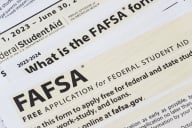You have /5 articles left.
Sign up for a free account or log in.

shironosov/istock/getty images plus
“Positionality” is a term that we in academe typically associate with research. Determining your positionality requires you to reflect on your multiple identities based on group memberships, roles and personal values and characteristics and to consider how your lived experiences and perceptions may influence your research questions, methods and the way you interpret research findings. Engaging in this process is common practice among researchers, especially those involved in qualitative research.
Reflecting on your positionality as it relates to your role as a college instructor, however, is not as common. That is unfortunate, as your position as a teacher influences your course design, teaching methods and feedback and grading practice—and all of these have a significant influence on student learning and success. Reflecting on your positionality as an instructor can be a powerful strategy for student success, especially if you think about how your lived experiences shape what you do in the classroom and how those actions may or may not be supporting the success of students in your class who often have very different lived experiences.
Instructors who have been using culturally responsive practices may have already started to engage in this reflective work. Many culturally responsive strategies require instructors to conduct an internal audit to explore their biases before assessing curriculum from an equity lens. Exploring your instructor positionality requires you to look closely at your experiences, beliefs and potential biases—and then consider their impact on your students.
What Is Your Instructor Positionality?
Ask yourself the following questions:
- What groups—race, gender, sexual orientation, age, social class, religion, ability and so on—do I identify with and how salient is each group membership to my identity and related actions as an instructor?
- What roles—significant other, parent, sibling, child, friend, instructor, scholar, author—do I have and how do these impact my identity and related actions as an instructor?
- What type of training and experiences do I have? How have they shaped who am I professionally today, and how might they positively or negatively impact marginalized populations in my classes today?
- What beliefs or values and characteristics do I have, and how do they impact my identity and related actions as an instructor?
- In what ways do my identities represent privilege or marginalization, and how might they compare to those of my students? How might I be engaging in actions that marginalize or discourage students? What actions do I take to promote student success for all the students in my classes?
After you have reflected on your positionality, consider what actions you might want to take as an instructor. For starters, consider sharing your positionality statement on the syllabus or verbally during an initial class session. Students will probably appreciate you sharing your multiple identities; it may help them feel connected to you, especially if you have shared identities. Learning about you may make it more likely for students to reach out and engage with you outside class.
Research has consistently shown that student-professor interactions are a powerful predictor of student success. I noticed that, as I started to share information about my multiple identities and explicitly invited students to talk with me outside class so I could get to know them, I had many more students visit me during office hours and reach out to me via email. During one of those visits, one student who was a single mother and caretaker for her mom said she felt understood and supported when I acknowledged that the university may not always be the priority and that I expected students to put loved ones first.
When you engage in this reflective exercise, you may decide to modify your course design or teaching approach to better meet the needs of your diverse students. For instance, this reflection may remind you of the importance of family for both you and your students. Examine your policies and practices to see if they’ve conveyed your views about the importance of family to your students. An example would be having a flexible late policy that acknowledges the complex lives we all live.
Perhaps through this process you discover that you are relying heavily on traditional assignments such as exams and papers because you experienced those types of assignments as a student and performed well on them. Yet students may have different and perhaps not as positive experiences with such traditional assessments. Giving students options with assignments is an excellent way to promote success in an equitable way. For example, students could choose to submit a paper, present on the topic, create an infographic or design a website.
Research has shown that equity gaps are more likely with traditional assignments such as exams or papers. There are numerous ways to teach and assess learning; some are more equitable than others. What worked for you as a learner may not be what works best for your students. So I often give students choices about how they can learn about a topic and how they can demonstrate what they have learned. Students can gather information by interviewing professionals in the field, following leaders and organizations on social media, listening to podcasts or recorded conference sessions, or reading traditional sources such as books and journals. Students can then share their findings via a Pecha Kucha–style presentation, blog, infographic or traditional research paper. One student shared that she was empowered by the option to interview a professional and that she would never have reached out to this person if she didn’t have this assignment. She was energized by the experience and thrilled to add this professional to her network. Another student shared that he was inspired to publish the blog post he wrote for the assignment.
Reflecting on what you are bringing to the classroom in terms of your identity, experiences and beliefs—and how those may differ from what your students are bringing—can help you identify ways to better connect and support your students. Reflection has always been a part of teaching. Instructors regularly reflect on what went well and what did not go well with various learning tasks and assessments. Go beyond reflecting on teaching strategies and think more about who you are and how you are conveying that to your students. Acknowledging the potential biases that you have can help you identify actions needed to create a student-centered, inclusive and equitable learning environment in your classroom.








